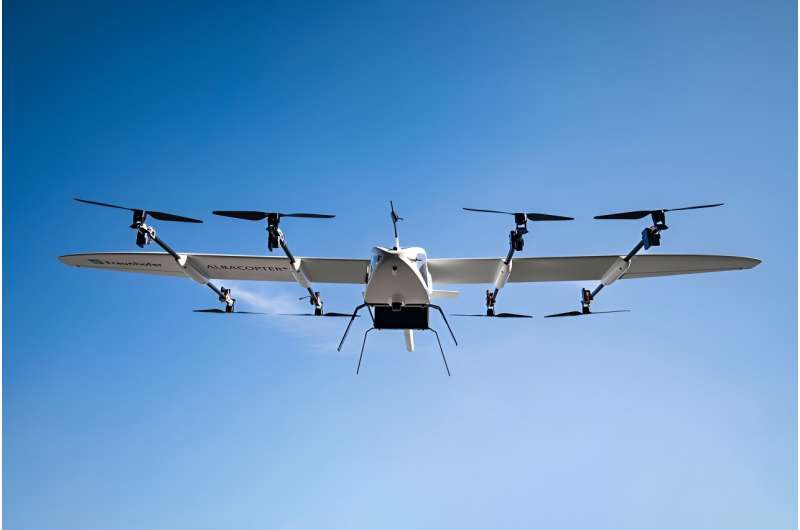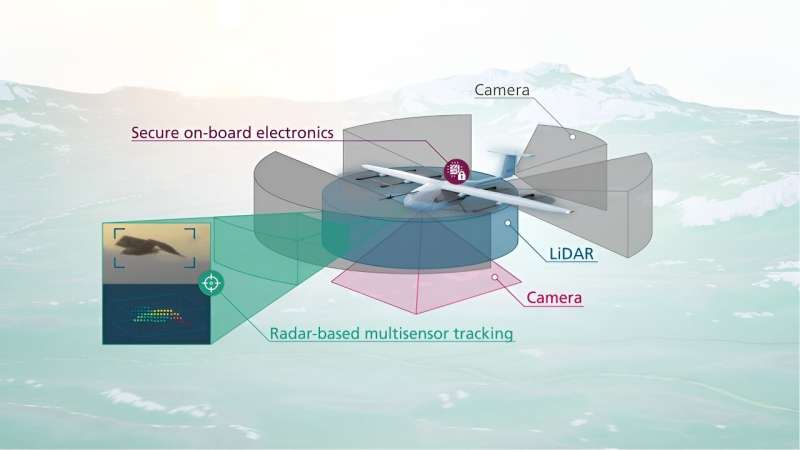This article has been reviewed according to Science X's editorial process and policies. Editors have highlighted the following attributes while ensuring the content's credibility:
fact-checked
trusted source
proofread
Autonomous cargo drone with sustainable structures and intelligent battery systems

Urban air mobility (UAM) does more than just open up new potential in terms of transporting goods: if some of urban traffic goes airborne, this will also offer completely new approaches when it comes to sustainable mobility solutions. In the Fraunhofer ALBACOPTER Lighthouse Project, six Fraunhofer institutes are addressing the technical and social issues associated with UAM.
Led by the Fraunhofer Institute for Transportation and Infrastructure Systems IVI, researchers have developed an aircraft that glides in a particularly efficient way—taking inspiration from the albatross. This device and other high-lights will feature at the joint Fraunhofer booth (D11, in Hall B1) at the IAA MOBILITY trade show in Munich from September 5 to 8, 2023.
UAM is subject to strict requirements for aircraft and system technology, including safe, quiet VTOL (vertical take-off and landing) systems that can also deliver very powerful propulsion performance when hovering.
The challenges of urban air transportation
Electric multicopters offer the benefits of VTOL agility while also fulfilling safety and environmental criteria; however, their range and payload capacity are extremely limited due to their low efficiency and low energy storage densities. Larger wings could significantly improve the crafts' energy balance by allowing them to glide for long periods.
On the other hand, these wings would hinder take-off and landing in urban areas. In addition, to make UAM financially viable, VTOL aircraft that fly autonomously will be required; however, this involves AI-based control systems, which create further safety risks.
For this reason, it can be assumed that in the future, UAM will become established via a wide range of paths, and that the aerospace technologies involved will be as varied as their use cases in sectors such as logistics drones, air taxis, rescue and surveillance drones and agricultural engineering.
The Fraunhofer ALBACOPTER lighthouse project
These factors prompted the launch of a Fraunhofer lighthouse project in 2021, with the objective of building a flying platform that could combine the agility of a multicopter with the efficiency of a glider. "With the ALBACOPTER, we aim to develop an experimental aircraft that pairs the maneuverability of a multicopter with an albatross' ability to glide long distances with minimal use of energy," explains Prof. Matthias Klingner, project manager and director of Fraunhofer IVI.
"Some exceptional features of this experimental VTOL glider include drone bodies and cargo containers made from sustainable materials, high-performance coaxial propulsion systems, powerful multi-sensor systems for perceiving the environment and monitoring functionalities, and failsafe on-board electronic systems including an AI-based autopilot," Prof. Klingner continues. The consortium has addressed the complexity of this drone design by pooling the expertise of the participating institutes.

Recyclable design meets innovative propulsion solutions
The Fraunhofer Institute for Structural Durability and System Reliability LBF designed the structure and aerodynamic components of the ALBACOPTER. For the structure, the Fraunhofer Institute for Chemical Technology ICT developed pultruded profiles, i.e., pultruded fiber-reinforced thermoplastics that were integrated into the space frame fuselage architecture.
As with the transportation containers, which are made from biopolymer hard foam, these system components can easily be recycled. "In contrast to today's eVTOL systems, which are usually equipped with direct drives, the efficient propulsion design used in the ALBACOPTER is based on high-speed synchronous motors with multi-stage transmission and high power density," explains Prof. Frank Henning, director of Fraunhofer ICT.
The institute provides not only the new propulsion technology but also a special propulsion test rig in order to facilitate testing of pivot-capable eVTOL propulsion systems in the power classes up to 450 kW under realistic conditions.
"The battery storage system design in ALBACOPTER is based on cycle-resistant secondary cells that guarantee highly reversible charging and discharging processes. We conducted detailed investigations into the degradation of the cells and possible failure mechanisms in the case of the kind of air flows that occur during flight phases with particular performance requirements," explains Prof. Tobias Melz, director of Fraunhofer LBF.
Safety first with cutting-edge sensors and artificial intelligence
Robust, light, high-performance multi-sensor systems are combined with the sensitive single-photon LiDAR detectors created by the Fraunhofer Institute for Microelectronic Circuits and Systems IMS to enable 360-degree environmental monitoring.
"The semantic 3D reconstruction of the environment is then carried out based on reliable AI systems. When combined with intelligent trajectory planning, this enables innovative functions such as autonomous (emergency) landing, which is among the most important safety features of the ALBACOPTER," explains Henri Meeß, manager of the Highly Automated Flying group at Fraunhofer IVI.
When these features are combined with a fail-safe RISC-V on-board electrical system architecture, continuous monitoring, stable 5G communications and a redundant autopilot system, the result is an overall system that fulfills all the high reliability requirements for UAM.
The autopilot system is backed up by a model-based flight attitude control system designed by the Fraunhofer Institute for Mechatronic Systems Design IEM. This keeps the aircraft stable, particularly during the critical transition phases between hovering and gliding.
Autonomous from the word go
The ALBACOPTER is intended to serve as a demonstrator for Fraunhofer technologies for which demand is predicted to rise during the next five to eight years in the rapidly growing aerospace and logistics sectors. Hybrid copter-gliders in the form of variable sweep-wing aircraft and multicopters with retractable wings and pivoting rotors are currently becoming established as a middle ground between helicopters, multicopters and conventional fixed-wing aircraft. As a VTOL glider, the ALBACOPTER will be available for testing all these different VTOL technologies.
The researchers are validating their design in multiple stages using suitable flight models, wind tunnel experiments, iron bird test rig structures and XiL system simulations on a digital twin developed by the Fraunhofer Institute for Optronics, System Technologies and Image Exploitation IOSB. A scaled version of the drone with a wingspan of 7 meters and a payload capacity of approx. 25 kilograms will be launched in fall 2023, while extensive flight tests of the ALBACOPTER are expected for early 2024.



















